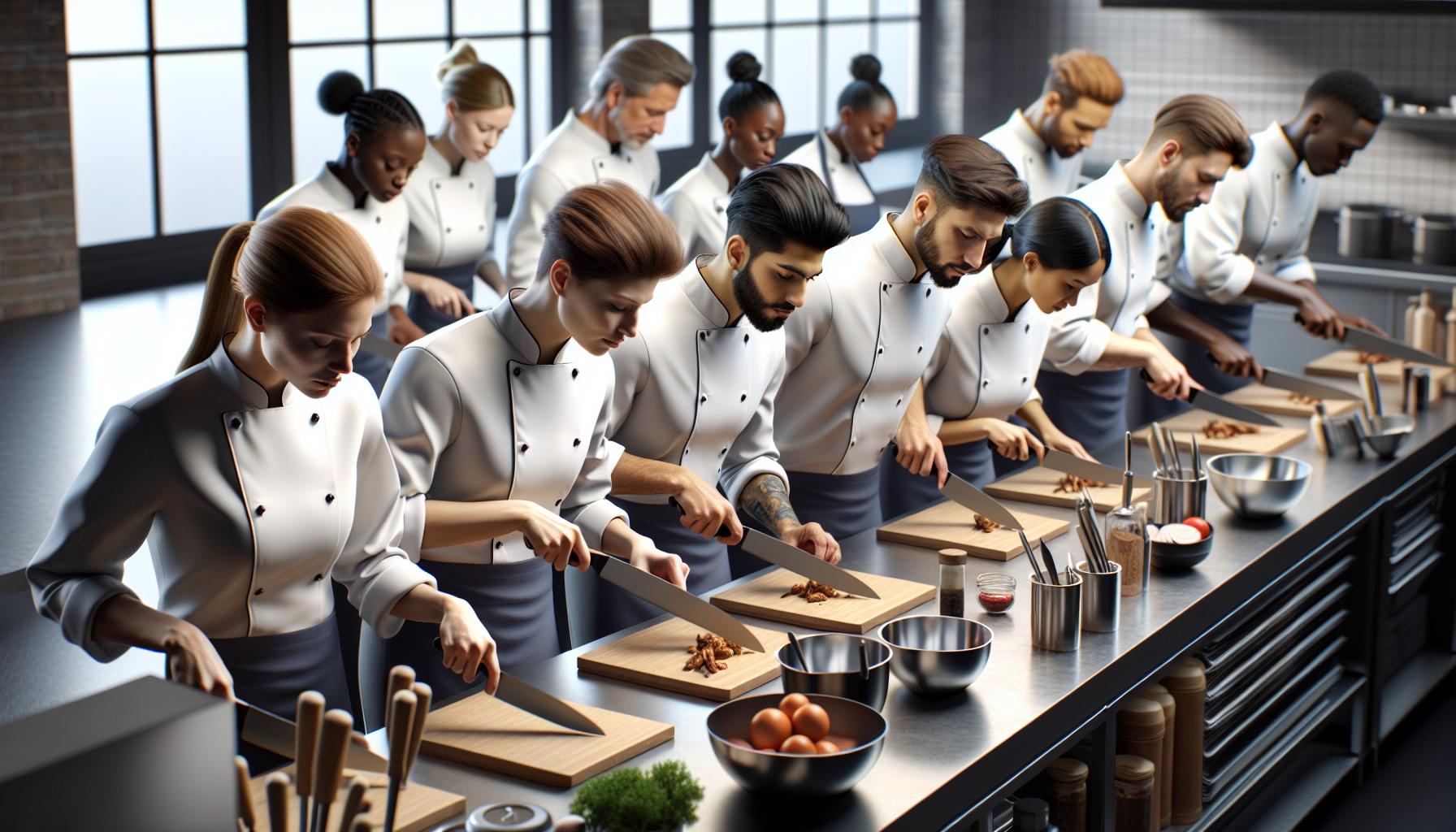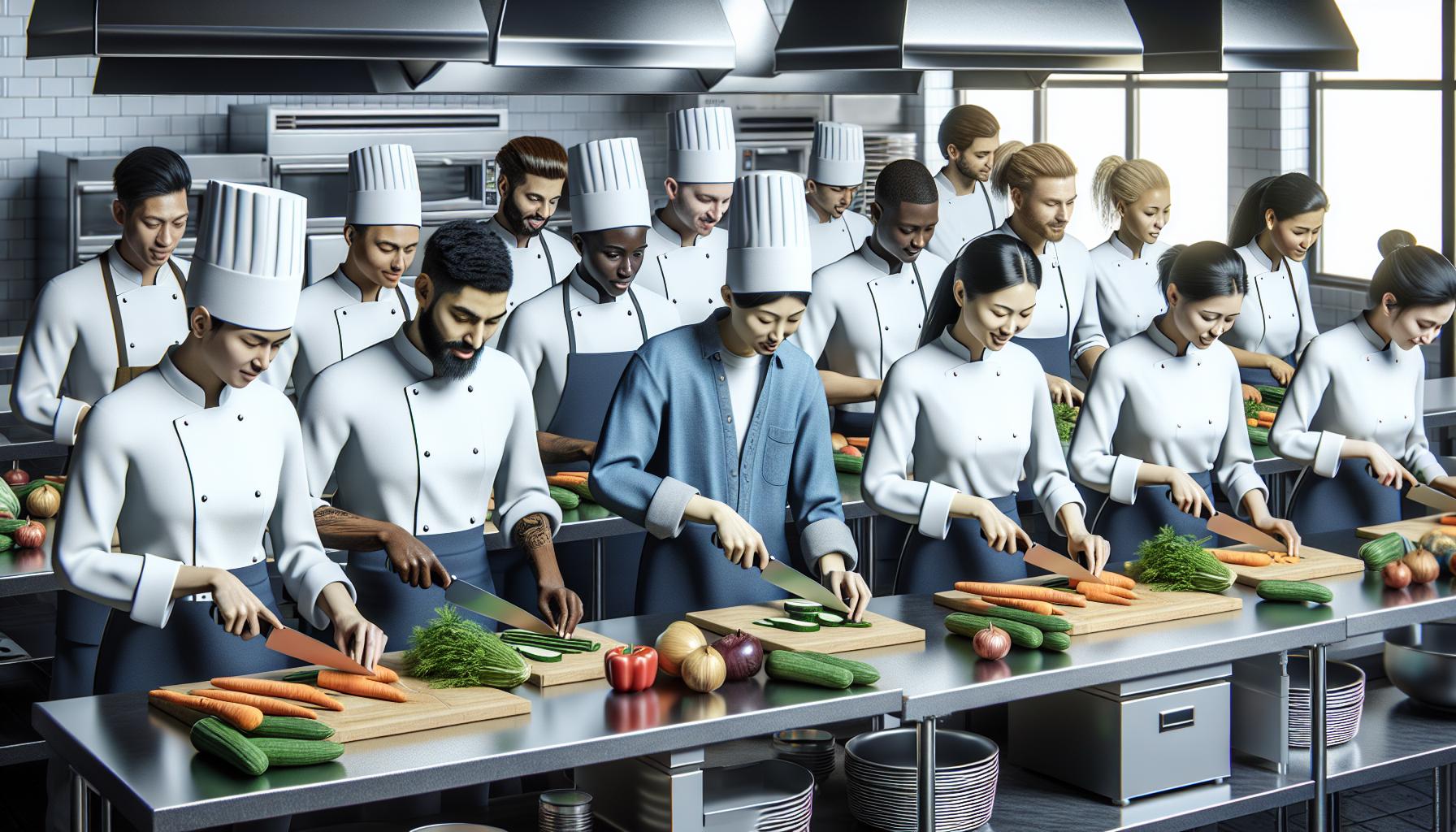Dreams of becoming a culinary mastermind don’t always require a four-year degree. Culinary arts trade schools offer aspiring chefs a direct path to kitchen success without the lengthy academic detours. These specialized institutions serve up hands-on experience alongside essential cooking techniques that transform passionate food lovers into professional chefs.
From mastering knife skills to creating exquisite sauces students at culinary trade schools dive straight into the heart of kitchen operations. They’ll learn from experienced chefs who’ve navigated the intense world of professional kitchens and understand what it takes to succeed. It’s where the art of cooking meets practical skills and where tomorrow’s culinary stars are born – all while keeping student loan debt to a simmer rather than a boil.
Culinary Arts Trade School
A culinary arts trade school focuses on teaching practical cooking techniques in specialized learning environments equipped with professional kitchen facilities. Students gain hands-on experience with kitchen equipment like commercial ovens, grills, mixers while learning essential food preparation skills.
These specialized institutions offer concentrated programs lasting 6 to 15 months, compared to traditional 2-4 year culinary degrees. Training emphasizes practical skills through:
- Direct mentorship from professional chefs
- Real-world kitchen scenarios
- Food safety certification preparation
- Menu planning exercises
- Inventory management practice
The curriculum combines classroom instruction with extensive kitchen time in the following areas:
- Classical cooking methods
- Knife skills mastery
- Sauce composition
- Baking fundamentals
- Food presentation techniques
Trade schools partner with local restaurants, hotels, catering companies to provide:
| Training Component | Duration | Focus Area |
|---|---|---|
| Kitchen Labs | 70% of program | Hands-on cooking |
| Classroom Study | 20% of program | Theory & safety |
| Industry Externship | 10% of program | Real workplace experience |
Students learn in small class settings with 12-15 participants per instructor, enabling personalized attention. Programs emphasize speed, efficiency, quality standards required in professional kitchens while building fundamental culinary knowledge through practical application.
Many culinary trade schools maintain job placement services connecting graduates with employment opportunities at restaurants, hotels, resorts, catering operations. Career guidance includes resume building, interview preparation, networking events with industry professionals.
Benefits of Attending Culinary School

Culinary school education provides valuable advantages for aspiring chefs seeking to excel in the food service industry. The structured learning environment accelerates skill development while creating opportunities for career advancement.
Professional Kitchen Skills
Students gain expertise in essential culinary techniques through intensive hands-on training programs. The curriculum covers advanced knife skills, ingredient identification, flavor profiling, kitchen equipment operation, food safety protocols, and inventory management systems. Specialized instruction focuses on classical French cooking methods, international cuisine preparation, pastry techniques, plate presentation, and portion control standards. Training incorporates modern kitchen technology, sustainable cooking practices, allergen awareness, and high-volume food production methods used in commercial settings.
Industry Connections
Culinary schools maintain strong partnerships with restaurants, hotels, resorts, and catering companies across the country. These relationships create externship opportunities at prestigious establishments where students apply their skills in professional environments. Leading chefs regularly visit campuses to conduct demonstrations, share industry insights, and scout emerging talent. Career services departments coordinate job fairs, networking events, and alumni mentorship programs that connect students with potential employers. Students gain access to exclusive job boards, internship databases, and professional associations that facilitate entry into the culinary workforce.
Types of Culinary Programs Available

Culinary arts trade schools offer diverse educational paths tailored to different career goals in the food service industry. Programs range from short-term certificates to comprehensive degree options, each providing specific skill sets and knowledge bases.
Certificate Programs
Certificate programs provide focused culinary training in 6-15 months, concentrating on essential kitchen skills and food preparation techniques. Students learn fundamental cooking methods, knife skills, kitchen safety protocols and food sanitation standards. The curriculum includes:
- Basic cooking techniques for proteins, vegetables and starches
- Kitchen equipment operation and maintenance
- Food safety and ServSafe certification preparation
- Basic baking and pastry fundamentals
- Menu planning and cost control basics
- Industry-standard plating techniques
These programs often feature 80% hands-on training through kitchen labs and 20% classroom instruction. Many certificates offer specializations in:
- Pastry and baking arts
- International cuisines
- Sustainable cooking practices
- Wine studies and beverage management
Associate Degree Options
Associate degree programs deliver comprehensive culinary education over 18-24 months, combining practical skills with business fundamentals. The curriculum encompasses:
- Advanced cooking techniques and cuisine styles
- Kitchen management and team leadership
- Food cost analysis and inventory control
- Restaurant operations and business planning
- Nutrition science and menu development
- Wine pairing and beverage program management
Students complete general education requirements alongside culinary courses, earning credits transferable to bachelor’s degree programs. The program structure includes:
- 60% hands-on kitchen training
- 25% classroom instruction
- 15% industry externship experience
These programs incorporate advanced technology training, sustainable practices and farm-to-table concepts into the core curriculum.
Core Curriculum and Training

The core curriculum in culinary arts trade schools combines essential kitchen skills with food safety protocols. Training focuses on practical applications through hands-on learning modules structured for career-ready outcomes.
Kitchen Fundamentals
Kitchen fundamentals training emphasizes mastery of classical cooking techniques through daily hands-on practice. Students learn precise knife skills including julienne, brunoise, chiffonade cuts through repetitive exercises with professional-grade equipment. The curriculum covers mother sauces (béchamel, espagnole, hollandaise, tomato, velouté) along with their derivatives through practical demonstrations. Advanced training includes meat fabrication, seafood preparation, vegetable cookery techniques. Students practice proper mise en place organization, temperature control methods, plating aesthetics. Equipment handling training covers commercial ranges, salamanders, convection ovens, commercial mixers. Recipe scaling, portion control, flavor profiling exercises develop crucial skills for high-volume production environments.
Food Safety and Sanitation
Food safety training centers on ServSafe certification requirements with emphasis on preventing foodborne illness. Students learn proper temperature danger zones (40°F-140°F), cooling procedures, storage protocols through hands-on demonstrations. The curriculum covers critical control points including receiving ingredients, storage rotation, preparation standards. Sanitation training includes proper handwashing techniques, cleaning schedules, sanitizing procedures for equipment surfaces. Students practice pest control measures, proper chemical storage, personal hygiene standards. Cross-contamination prevention methods focus on color-coded cutting boards, separate prep areas, allergen protocols. Regular inspections simulate health department visits to reinforce food safety compliance standards.
Career Opportunities After Graduation
Culinary arts trade school graduates enter a diverse job market with multiple career paths in the food service industry. Their specialized training creates opportunities in both traditional restaurant settings and emerging culinary sectors.
Restaurant Positions
Graduates qualify for positions ranging from line cook to executive chef in various dining establishments. Entry-level roles include prep cook positions at casual dining restaurants, paying $28,000 to $35,000 annually. Mid-level opportunities encompass sous chef positions at upscale restaurants, offering salaries between $45,000 to $65,000. Specialty positions include pastry chefs at boutique bakeries, garde manger chefs managing cold food preparation, and sauciers crafting signature sauces at fine dining establishments. Experience combined with formal training enables advancement to executive chef roles at high-end restaurants, with potential earnings of $75,000 to $120,000 annually.
Food Service Management
Management opportunities span across hotels, resorts, corporate dining facilities, and catering companies. Food service directors oversee operations at healthcare facilities, educational institutions, and corporate cafeterias, earning $55,000 to $85,000 annually. Restaurant managers coordinate staff scheduling, inventory control, and quality assurance at dining establishments. Catering managers organize events, design menus, and manage service teams for private functions. Corporate food service managers supervise multiple locations, implement standardized procedures, and maintain profit margins across chain restaurants. These positions typically require 3-5 years of kitchen experience combined with formal culinary education.
Cost and Financial Aid Options
Culinary arts trade school tuition ranges from $15,000 to $45,000 for complete program completion. Program costs vary based on location, duration, and included materials such as knife sets, uniforms, and textbooks.
Several financial aid options make culinary education more accessible:
- Federal Pell Grants provide up to $6,895 per academic year for eligible students
- Direct Subsidized Loans offer need-based funding with deferred interest
- Work-study programs enable students to earn $3,000 to $5,000 per semester through campus kitchen positions
- Industry-specific scholarships from organizations like James Beard Foundation award $2,500 to $10,000
- Merit-based institutional grants reduce tuition by 10% to 30% for qualifying students
| Cost Component | Price Range |
|---|---|
| Tuition | $15,000 – $45,000 |
| Equipment Kit | $800 – $1,500 |
| Uniforms | $300 – $500 |
| Textbooks | $500 – $1,000 |
Payment plans break down tuition into monthly installments of $500 to $1,500. Many schools partner with culinary industry employers offering tuition reimbursement programs covering 50% to 100% of education costs. Veterans receive additional benefits through the GI Bill, covering tuition fees and providing monthly housing allowances.
Financial aid offices assist students in identifying scholarships from culinary associations, food manufacturers, and restaurant groups. Professional organizations like the American Culinary Federation provide members access to exclusive scholarship opportunities ranging from $1,000 to $5,000 per academic year.
Choosing the Right Culinary School
Selecting an appropriate culinary arts program requires careful evaluation of several key factors. The decision impacts career opportunities, skill development potential, and return on educational investment.
Program Accreditation
Accreditation from recognized culinary organizations validates a school’s educational standards and curriculum quality. The American Culinary Federation (ACF) provides the primary accreditation for culinary programs in the United States, ensuring programs meet strict educational standards. Programs earn accreditation through rigorous evaluations of faculty qualifications, facilities, curriculum content, and student outcomes. ACF-accredited schools maintain specific instructor-to-student ratios, updated kitchen equipment, and comprehensive course materials covering essential culinary competencies. Students at accredited institutions gain access to additional scholarship opportunities, industry recognition, and transferable credits to other culinary institutions.
Industry Reputation
Top culinary schools maintain strong relationships with prestigious restaurants, hotels, and food service organizations. Distinguished programs showcase successful alumni working in Michelin-starred restaurants, leading hotel chains, and prominent catering companies. Industry leaders actively recruit from reputable schools, participating in career fairs and offering exclusive externship opportunities. Employment data reveals graduates from well-respected programs secure positions at higher rates, with 85% finding relevant culinary work within six months of graduation. These institutions feature experienced faculty members who maintain active connections in the culinary world, bringing current industry trends directly into the classroom.

